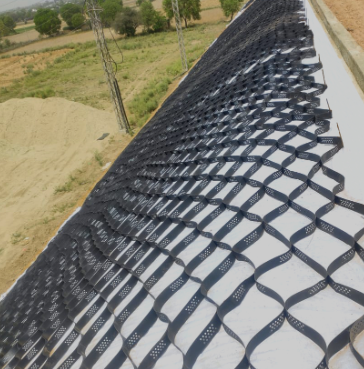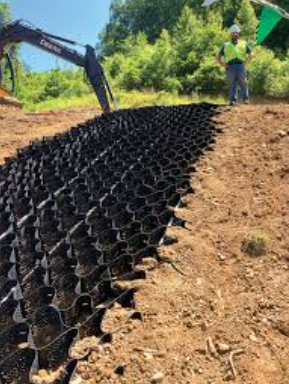- Understanding the Role of Geomembrane Liners in Waste Management
- Innovations in Geomembrane Liners for Water Management
- Geomembrane Liners: A Comprehensive Guide
- The Future of Geomembrane Liners in Civil Engineering
- Geomembrane Liners: Enhancing Landfill Stability
Manager:
WhatsApp:+86 177 0135 2670
Tel:+86 177 0135 2670
Email:marketing@okorder.com
Address:3rd Floor, No.2 Building, No.1 Sanlihe Road
What do you fill geocell with?
Introduction
Geocell slope protection has emerged as a versatile solution for stabilizing slopes, preventing erosion, and reinforcing soil in various civil engineering projects. One of the key questions in geocell slope protection revolves around the filling material. What exactly do you fill geocell with to maximize its effectiveness? In this comprehensive guide, we delve into the considerations, options, and best practices for filling geocells in slope protection applications.

Understanding Geocell Slope Protection
Before diving into the filling materials, let's understand what geocell slope protection entails. Geocells are three-dimensional, honeycomb-like structures made from durable materials such as high-density polyethylene (HDPE). When deployed on slopes, these cells confine soil or aggregate, creating a stable layer that resists erosion, minimizes surface runoff, and enhances load-bearing capacity.
The Role of Filling Material
Filling material plays a crucial role in the performance of geocell slope protection systems. It serves multiple functions, including:
1. Stability: The filling material provides weight and mass, enhancing the stability of the slope and preventing soil displacement.
2. Erosion Control: It helps mitigate erosion by reinforcing the soil and reducing surface runoff velocity.
3. Vegetation Support: Certain filling materials support vegetation growth, promoting natural erosion control and enhancing aesthetic appeal.
4. Drainage: Properly selected filling material facilitates efficient drainage, preventing water buildup behind the slope and reducing hydrostatic pressure.
Factors Influencing Filling Material Selection
Several factors influence the choice of filling material for geocell slope protection:
1. Slope Gradient: Steeper slopes may require heavier, more stable filling materials to prevent slippage and erosion.
2. Environmental Conditions: Considerations such as rainfall intensity, temperature fluctuations, and freeze-thaw cycles dictate the resilience and durability of the filling material.
3. Vegetation Requirements: If vegetation establishment is desired, the filling material should support plant growth by providing nutrients and adequate moisture retention.
4. Load-Bearing Capacity: The filling material should complement the geocell's load-bearing capacity, ensuring structural integrity under anticipated loads.
5. Project Budget: Cost considerations may influence the selection of filling material, balancing performance requirements with budget constraints.
Options for Filling Geocell
Several options are available for filling geocells in slope protection applications, each with its unique characteristics and suitability:
1. Gravel or Crushed Stone: Gravel or crushed stone is a common choice for filling geocells, offering excellent stability, drainage, and erosion control. It provides structural support while allowing water to permeate through, reducing the risk of surface runoff and erosion.
2. Soil: Depending on the project requirements, native soil or engineered soil mixes can be used as filling material. Soil offers natural integration with the surrounding environment and supports vegetation growth. However, soil composition and compaction must be carefully managed to ensure stability and performance.
3. Concrete or Cementitious Fill: In some cases, concrete or cementitious fill may be used to provide additional weight and stability, especially in areas prone to erosion or seismic activity. These materials offer high strength and durability but may be more expensive and less environmentally friendly than other options.
4. Vegetative Fill: For eco-friendly slope protection solutions, vegetative fill such as topsoil or compost-enriched soil can be used. These materials support vegetation growth, enhancing slope stability while providing aesthetic benefits. However, vegetative fill requires careful selection and maintenance to ensure successful establishment and erosion control.
Best Practices for Filling Geocell
To maximize the effectiveness of geocell slope protection, adhere to the following best practices when filling geocells:
1. Proper Compaction: Ensure thorough compaction of the filling material to minimize settling and maintain slope stability over time.
2. Gradation Control: Use well-graded filling materials to optimize drainage and prevent particle segregation, which can compromise performance.
3. Quality Assurance: Verify the quality and compatibility of the filling material with the geocell system to prevent compatibility issues or premature failure.
4. Surface Preparation: Adequately prepare the slope surface before filling geocells to remove debris, vegetation, and unevenness that may affect performance.
5. Consider Maintenance: Factor in long-term maintenance requirements when selecting filling material, choosing options that facilitate vegetation establishment and erosion control with minimal upkeep.

Conclusion
Geocell slope protection offers an effective solution for stabilizing slopes, preventing erosion, and enhancing environmental sustainability in civil engineering projects. Choosing the right filling material is crucial to the success of geocell slope protection systems, considering factors such as stability, erosion control, vegetation support, and project requirements. By understanding the options, factors, and best practices outlined in this guide, engineers and project managers can confidently select and utilize filling materials to optimize the performance and longevity of geocell slope protection installations."






